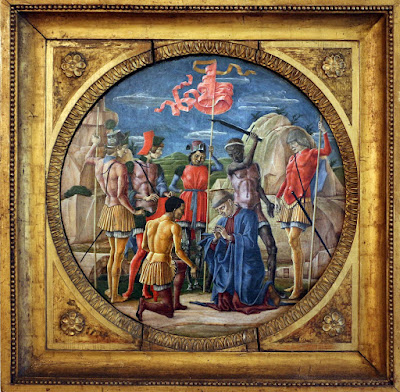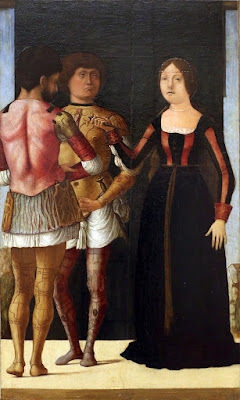 |
| attributed to Angelo Maccagnino St Mary of Egypt ca. 1447-56 tempera on panel Museo di Castelvecchio, Verona |
 |
| Angelo Maccagnino Portrait of a Lady ca. 1447-56 tempera on panel Museo Correr, Venice |
The early life and training of Angelo Maccagnino, born in Siena, is poorly documented. His surviving works were created in Ferrara, where from the mid 1440s to the mid 1450s he served first in the court of Leonello d'Este, and subsequently in that of Leonello's brother and successor Borso. In Ferrara, Maccagnino was influenced by recently imported works of the innovative Netherlandish painter Rogier van der Weyden
 |
| Cosmè Tura Trial of St Maurelius 1480 tempera on panel Palazzo dei Diamanti, Ferrara |
 |
| Cosmè Tura Martyrdom of St Maurelius 1480 tempera on panel Palazzo dei Diamanti, Ferrara |
 |
| Cosmè Tura St George and the Dragon ca. 1460-65 tempera on panel Palazzo dei Diamanti, Ferrara |
 |
| Cosmè Tura Portrait of a Young Man of the Este Family ca. 1470-80 tempera on panel Metropolitan Museum of Art, New York |
 |
| Cosmè Tura Adoration of the Magi ca. 1480 tempera on panel Harvard Art Museums |
"Cosmè Tura, born about 1433, the son of a Ferrarese shoemaker, spent nearly all his known career in Ferrara. Beginning in 1451 he worked regularly for Borso d'Este and Ercole I d'Este, and carried out private commissions from leading families for chapels in local churches. Tura's artistic beginnings are difficult to trace because neither records of his training nor documented early works survive. . . . Much of Tura's documented work as court painter for the Estensi consisted of festive decorations – triumphal cars, harnesses, parade banners, shields, and caparisons – and he designed tapestries and silver vessels for the rulers of Ferrara; such pieces must have encouraged his decorative and lively painting style. Unfortunately, nearly all of his secular work is now lost. . . . Although he lived until April 1495, Tura's documented activity for the Este court ends in the mid-1480s, and we have no evidence that he worked on any major commissions during his last ten years, when he was apparently in poor health. Besides, Tura's lively, linear manner was losing favor during the 1480s. After his activity at the Este court ceased, Ercole de' Robert's more moderate style, with broader figures and softer modeling, came to prevail."
– from biographical notes at the National Gallery of Art, Washington DC
 |
| Ercole de' Roberti and Giovanni Francesco Maineri Lucretia, Brutus and Collatinus ca. 1490 tempera on panel Palazzo dei Musei, Modena |
 |
| Ercole de' Roberti Portia and Brutus ca. 1486-90 tempera on panel Kimbell Art Museum, Fort Worth, Texas |
 |
| Ercole de' Roberti Institution of the Eucharist (predella fragment) ca. 1490-95 tempera on panel National Gallery, London |
 |
| Ercole de' Roberti Institution of the Eucharist (detail) (predella fragment) ca. 1490-95 tempera on panel National Gallery, London |
 |
| Ercole de' Roberti Israelites gathering Manna (detail) (predella fragment) ca. 1490-95 tempera on panel National Gallery, London |
 |
| Ercole de' Roberti Israelites gathering Manna (detail) (predella fragment) ca. 1490-95 tempera on panel National Gallery, London |
 |
| Ercole de' Roberti Israelites gathering Manna (detail) (predella fragment) ca. 1490-95 tempera on panel National Gallery, London |
 |
| Ercole de' Roberti St Michael Archangel (fragment of Griffoni Polyptych) ca. 1470-73 tempera on panel Musée du Louvre |
"Roberti was born by the mid-1450s, presumably in Ferrara. . . . In early 1479 Roberti is recorded as having established a workshop in Ferrara. . . . By 1486 he was working in Ferrara as court painter for Ercole I d'Este, and remained there until his death in 1496. Much of his work for the Estensi consisted of such ephemera as triumphal cars and pennants; he also decorated wedding chests for the Este princesses Isabella and Beatrice (1489-90). . . . Roberti's high reputation was fixed by Vasari's Vite, and the centuries could do little to erode it. Indeed, the Italian connoisseur Roberto Longhi judged Roberti to be the leading artist in Italy toward the end of the fifteenth century, equaled perhaps only by Leonardo. Roberti's essential contribution was to fuse the mannered, artificial style of Ferrara with contemporary Venetian art, Netherlandish painting, German engravings, and classical sculpture and architecture. His surviving oeuvre of about thirty-five paintings and drawings is rich, varied, and marked by a high level of technical competence."
– from biographical notes at the National Gallery of Art, Washington DC












































